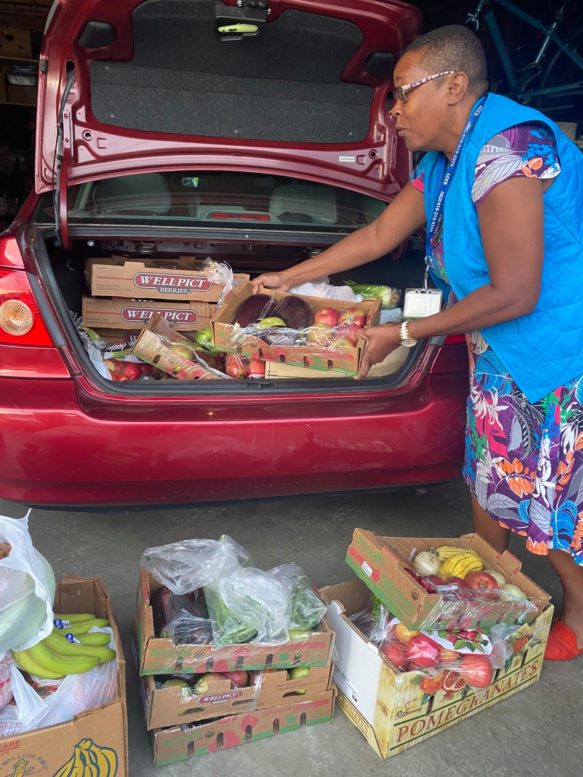As the coronavirus pandemic enters its third year, Ohio’s foodbanks are in a perilous state, an official who helps run them said Wednesday.
The centers have gotten through the crisis with special relief funds and help from the National Guard. But as happened repeatedly through the pandemic, foodbanks are facing increasing strains as temporary relief is poised to expire, said Lisa Hamler-Fugitt, executive director of the Ohio Association of Foodbanks.
Worse, the foodbanks’ calls for help are being made to a pandemic-weary public.
“Here we are, 22 months into this, and we’re looking down the barrel at the fifth surge (of coronavirus) and I would say there’s less compassion and concern among the general population,” Hamler-Fugitt said. “I get that everybody’s tired of this, but just think about the folks who are on the front lines.”
The foodbanks, nutrition source of last resort for many Ohioans, are facing the same headwinds as many other sectors.
They have increasing food costs. For example, a 10-pound bag of potatoes is now $1.35, up from 80 cents last year, Hamler-Fugitt said.
Those costs, together with rising housing and energy costs, have driven greater numbers of the elderly and others on fixed incomes to seek assistance at the foodbanks.
In addition, corporate donations have dropped with more employees working from home and donation drives suffering as a consequence. And food manufacturers have much less surplus to donate as they fall prey to the same supply-chain woes as so many other businesses, Hamler-Fugitt said.
At the same time, overworked staff at the foodbanks is reaching a breaking point.
They had been helped by a National Guard deployment of unprecedented length, but that ended in July. And now, with Gov. Mike DeWine deploying the Guard to help hospitals groaning under the strain of the latest covid surge, it might be unrealistic for foodbanks to expect further help from that quarter.
“How much can we ask of our citizen soldiers and their families?” Hamler-Fugitt asked. “Some of these men and women have been deployed for two friggin years. They were critical to our operations and we’re so grateful.”
Amid those strains looms another, huge one. A $250-$300 per-month, per-child tax credit under the American Rescue Plan is due to expire next week. Hope for further such funding died along with President Joe Biden’s Build Back Better plan, which was opposed by congressional Republicans and a Democrat, Sen. Joe Manchin of West Virginia.
Hamler-Fugitt said that when the enhanced credit began last summer, Ohio foodbanks saw easing demand as families with children started using grocery stores instead of food banks to meet their most basic needs.
“There are literally going to be tens of millions of families (in the United States) who have been relying on that child tax credit, and there won’t be a check on the 15th of January,” Hamler-Fugitt said.
To counter all these headwinds, the Ohio Association of Foodbanks is asking the DeWine administration for support from the more than $3 billion in American Rescue Act funds still available to the state. The association is asking for $183 million to bolster foodbank infrastructure and for supplies.
“The pandemic has revealed how quickly families can fall into economic hardship and food insecurity,” the Association of Foodbanks said in an Oct. 6 letter to DeWine. “During state fiscal year 2021, our statewide network has continued to provide take-home groceries and other food to nearly 1 million individuals every month. Although we were able to weather the storm, we struggled — and still worry about our ability — to purchase enough food to meet demand due to increasing food costs and unreliable supply chains.”
The DeWine administration didn’t respond to a request for comment.
***
Also from Ohio Capital Journal:
Ohio is 2nd in nation for COVID-19 deaths over last week
Ohio is second in the nation per capita in terms of the reported COVID-19 death rate over the last seven days, according to a database from The New York Times.
Only Wyoming experienced a higher rate of COVID-19 deaths over the past week, the data shows.
Nearly 30,000 Ohioans have died of COVID-19, including some 19,000 who died after federal officials first authorized use of COVID-19 vaccines for the public on Dec. 14, 2020. The data (by date of death) lags by several weeks, but about 86 Ohioans per day were dying of the disease in the first week of December 2021. READ MORE
Commentary – The ‘sore loser effect’: Rejecting election results can destabilize democracy, drive terrorism
An attendee at an October 2021 political rally hosted by right-wing activist Charlie Kirk asked: “How many elections are they going to steal before we kill these people?”
The attendee was referring to the baseless allegation that Joe Bidenstole the 2020 U.S. presidential election and that he unfairly denied Donald Trump reelection.
Kirk, CEO of Turning Point USA, condemned the question. But one year after the Capitol insurrection that was fueled by Trump’s claims of a rigged election, Kirk, other commentators and politicians – and, of course, Trump himself – continue to fuel false beliefs of widespread election fraud. Embrace of the “Big Lie” that Trump really won the election has become an article of faith for many Republican politicians. It is also widely believed by conservative Americans; in an October, 2021 poll, 60% of Republicans said the 2020 presidential election results should definitely or probably be overturned.
This creates a potentially dangerous situation for the United States. Acceptance of electoral defeat, something political scientists call “loser’s consent,” is essential for stability and order in democracies. READ MORE





